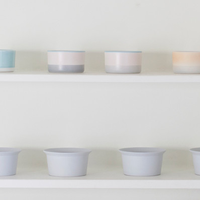Exhibition: "Reviving Myanmar Celadon Ceramics" | Singapore
 The National University of Singapore Museum (NUS Museum), an ASEMUS member, presents an exhibition entitled "From the Ashes: Reviving Myanmar Celadon Ceramics", between 9 February and 30 December 2017.
The exhibition introduces the ash glazed wares produced by Myanmar potters in the 15th century and the current attempts to revive and develop this tradition. Archaeological investigations in Lower Myanmar in the 1990s revealed historical kiln complexes specialised in making greenware (celadon). Identical wares uncovered on 15th-century shipwrecks in Southeast Asian waters and at land sites in the Persian Gulf suggest that Myanmar celadon was commercially distributed.
Chinese celadon, exported since the Song period, is a popular area of study among ceramics scholars. A body of research on Thai celadon is also available and investigations of the cargo from shipwrecks have shown that Thai kilns were active exporters of celadon ware for about a hundred years from the early 15th century (Brown 2009: 51-68). In comparison, the awareness among scholars of Myanmar as a notable celadon production centre has emerged only in the last 20 years with the discovery of ancient crossdraft kilns.
Celadon is cherished for the thick and lustrous quality of its glaze which gives the piece a jade-like appearance. Celadon wares come in a spectrum of green colours which are derived from the iron and titanium oxides in the glaze when the amount of oxygen is reduced during firing. Silica is the compound in the glaze that yields the glass like finish. To lower the melting point of silica, wood ash is added as a flux and hence the term 'ash glazed wares'. Pieces from the historical kilns of Lower Myanmar tend to sport an olive green tint and numerous bowl and plate fragments covered with such glazes have been recovered from excavated kilns and from the surface of unexcavated production sites.
Recent discoveries have prompted the Myanmar Ceramic Society to introduce the technique of ash glazing to invigorate the contemporary pottery industry for which unglazed earthenware is the primary product. The current experiments include a compound known as borax to lower the melting point of the glaze, resulting in ash glaze pottery which can be fired at a lower temperature. The new wares are named 'celabon', derived from 'celadon', which inspired the development, and 'borax'.
For additional information about "From the Ashes: Reviving Myanmar Celadon Ceramics", please visit http://community.nus.edu.sg/cfa/museum/exhibitions.php?sort_by=date_start&sort=DESC&month=&year=2017&genre=&keyword=&catid=111&active=Yes&month_end=Yes&&itemid=419
The National University of Singapore Museum (NUS Museum), an ASEMUS member, presents an exhibition entitled "From the Ashes: Reviving Myanmar Celadon Ceramics", between 9 February and 30 December 2017.
The exhibition introduces the ash glazed wares produced by Myanmar potters in the 15th century and the current attempts to revive and develop this tradition. Archaeological investigations in Lower Myanmar in the 1990s revealed historical kiln complexes specialised in making greenware (celadon). Identical wares uncovered on 15th-century shipwrecks in Southeast Asian waters and at land sites in the Persian Gulf suggest that Myanmar celadon was commercially distributed.
Chinese celadon, exported since the Song period, is a popular area of study among ceramics scholars. A body of research on Thai celadon is also available and investigations of the cargo from shipwrecks have shown that Thai kilns were active exporters of celadon ware for about a hundred years from the early 15th century (Brown 2009: 51-68). In comparison, the awareness among scholars of Myanmar as a notable celadon production centre has emerged only in the last 20 years with the discovery of ancient crossdraft kilns.
Celadon is cherished for the thick and lustrous quality of its glaze which gives the piece a jade-like appearance. Celadon wares come in a spectrum of green colours which are derived from the iron and titanium oxides in the glaze when the amount of oxygen is reduced during firing. Silica is the compound in the glaze that yields the glass like finish. To lower the melting point of silica, wood ash is added as a flux and hence the term 'ash glazed wares'. Pieces from the historical kilns of Lower Myanmar tend to sport an olive green tint and numerous bowl and plate fragments covered with such glazes have been recovered from excavated kilns and from the surface of unexcavated production sites.
Recent discoveries have prompted the Myanmar Ceramic Society to introduce the technique of ash glazing to invigorate the contemporary pottery industry for which unglazed earthenware is the primary product. The current experiments include a compound known as borax to lower the melting point of the glaze, resulting in ash glaze pottery which can be fired at a lower temperature. The new wares are named 'celabon', derived from 'celadon', which inspired the development, and 'borax'.
For additional information about "From the Ashes: Reviving Myanmar Celadon Ceramics", please visit http://community.nus.edu.sg/cfa/museum/exhibitions.php?sort_by=date_start&sort=DESC&month=&year=2017&genre=&keyword=&catid=111&active=Yes&month_end=Yes&&itemid=419Similar content
28 Nov 2017 - 04 Mar 2018
22 Dec 2015 - 21 Feb 2016
10 May 2017 - 09 Jul 2017
17 Sep 2014
02 Aug 2016 - 23 Oct 2016
posted on
26 Mar 2015

